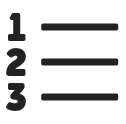Being a Web Editor in Modern Campus CMS comes with an important responsibility of effective digital communication. Though writing content may initially seem as straightforward as any other form of writing, there are a number of nuances to writing compelling, comprehensive, and clear content for your CalLutheran.edu audience.
It can be tempting to put off writing until you have a fully formed idea of your page design, however, it is usually most effective to write first, and design second. As you focus in on the written content for your section of the website, consider these key principles to quickly captivate your web audience.
Resource: Refer to the official university Stylebook for rules on editorial style and terminology.
How to Write Content for the Web
Know Your Target Audience
If you are writing content for the web, the first thing you need to know is who you are trying to reach.
As a guideline, the primary target audience of the CalLutheran.edu website is prospective students and families who are thinking about attending Cal Lutheran, as well as current students who are seeking specific assistance. Though each section of the website is intended for a subset of these target audiences (and some sections are intended for other audiences), it is important to know that this is the general audience when people visit the CalLutheran.edu website in search of information.
For your specific section of the website, consider your audience's unique needs when they visit your page(s). Your goal is to create content that relates to their situation and focuses on the value that you can offer them. What "pain points" do they have that your services provide solutions for?
EXTRA INSIGHT: Because our primary target audience focuses on prospective students and families, they tend to be less familiar with the university's org chart. Therefore, the CalLutheran.edu website is built on topics that are intuitive for our external audience rather than our internal organizational structure.
Identify the Key Topics
Because the purpose of your content is utilitarian in nature, it exists to serve a practical need of the audience. Therefore, you want to determine the topics that are most important to write about before you begin writing.
Consider creating an outline to guide your process. After you have an initial outline, you can begin to write a first draft of content by expanding as much or as little as needed until you have fully addressed each topic.
Put the Important Words First
In all types of written content, the first words count the most. People tend to spend more time looking at the first few words to see if a page is useful to their reason for visiting, so it is essential to get their attention quickly. As people skim, they make snap judgments on what to consume.
For this reason, it is best to make the purpose of your content clear at the very top of the page, before the reader needs to scroll down. This is typically initiated by the Section Title and Page Titles, but you can elaborate with intro text that is available through the Styles menu. After the introduction, make sure that the most important content is placed high up on the page, and maintain a logical order of ideas so that your readers absorb the information readily.
Conduct a Conversation in the "Second Person"
When you write for the web, envision that you are conversing with someone who is in your target audience. By treating it as a conversation and not a lecture, your content will feel personal and relatable to the reader.
For this to be most effective, it is typically best to address the reader with you or your pronouns and refer to the department that you represent (or the university) with we, us, or our pronouns. Grammatically, this is known as writing in the “second person” point of view, which is an element of voice that is utilized throughout the entire CalLutheran.edu website.
PRO TIP: To help align your writing with Cal Lutheran's style, refer to the university's Brand Identity guidelines for Writing, Voice and Tone.
- Stylebook - The official guide for writing styles and terminology unique to Cal Lutheran.
- University Names - Learn how to properly refer to the name of the university
Carry a Consistent Narrative
The narrative of content on a page content should maintain a consistency for any repeating elements. Consistent phrasing is particularly important for Page Titles, Headings, and any sub-headings or descriptions that appear multiple times on a page.
While there is no "one size fits all" rule for this across the CalLutheran.edu website, maintaining a consistent narrative on your department's section of the website can help your readers ascertain key ideas.
As an example, imagine that you see the following headings when you scroll down a page about admissions:
Which Major is the Best Choice for You (and Your Family)?
Visit Campus Today!
Financial Aid: Learning How Much Cal Lutheran Will Cost
How to Contact Us
Apply
Then, imagine that you see the following headings as a revised version of the above headings:
Find Your Major
Schedule a Tour
Learn About Costs
Connect With Us
Apply Online
The revised set of headings is preferred because it maintains consistent phrasing, by starting with a verb and being 2-3 words in length. This avoids the unnecessary distractions of the first set of headings, which vary in phrasing between a question format, exclamation format, two-part colon format, and short/long format.
Keep It Short and Simple
Although you are an expert in the subject matter of your content, your audience has a basic understanding. Write sentences with a simple structure and keep paragraphs short. Pretend you are writing to a 5th grader.
Here are some more specific tips to keep your content brief:
- Choose efficient words: select strong verbs, delete flowery adjectives, avoid phrases that have abstract/multiple meanings, skip acronyms, and condense lengthy verbiage into concise ideas.
- Break long sentences into short sentences: if it reads well, two short sentences beats one long sentence.
- Limit most paragraphs to one to four sentences: short paragraphs are easy to read, and it is perfectly fine if some paragraphs only have a single sentence.
No matter your approach, what is most important is that you allow yourself to be aggressive during the final editing stage. Cut excess verbiage and omit unnecessary words to yield the simplest and clearest communication of your message.
PRO TIP: The best Web Editors slim down a first draft of content to about half of its original length by the time it is published. Don't be bashful in the endeavor to be brief!
Use Lists for Multiple Items
When you have multiple pieces of information to write about, it is most effective to present the content in the format of a list. You have access to two types of list tools in the editor toolbar:
- Ordered List
 tool is best for items that are listed in a particular sequence.
tool is best for items that are listed in a particular sequence. - Unordered List
 tool is best for items that are listed in no particular sequence.
tool is best for items that are listed in no particular sequence.
Choosing the most appropriate list tool for your content will improve the accessibility of your page for people with disabilities, so that the content can be correctly understood.
Proofread for Spelling, Grammar, Punctuation, and Capitalization
By writing content for the CalLutheran.edu website, you are representing the university as an organization and a brand. Though it may seem obvious that typos would be discouraged for university web content, they are more common than you might imagine.
When you reach a polished draft of content, proofread it multiple times to ensure that all words are speled correctly, grammar are used properly, punctuat!on is accurate, and only the necessary Words are capitalized.
EXTRA INSIGHT: Need to triple check your content? Recruit a trusted colleague to proofread your draft, or try the special trick of reading your draft backwards, to help you find mistakes more easily.
Don't Worry About the Design...Yet
It is important to remember that people visit webpages for their useful information, not their visual design. This is quite different from a museum or art gallery, where visitors are seeking a thought-provoking experience of artistic wonder.
Clear, accurate, and timely information that answers key questions is the "value" that people seek when spending time on a website. While a pretty design may add value to engage your audience, the visual experience only exists to enhance the content strategy. The content should always be your primary focus.
Example of Optimizing Content
The "Original' example below is a dense paragraph with many different, but related, topics squeezed together. It's possible that a reader might miss the answer to their question if they only skim this paragraph quickly.
Instead, we apply these principles:
- Each sub-topic should be broken out with it's own heading
- Sentences should be short and use clear, plain language
- Bullet points should be used to turn long sentences into short lists
- Links should be added when referring to topics on other pages
The optimized result looks longer and more complicated, but is actually much easier to scan and find the answer to your question.
Original
Students may audit a lecture course upon the approval of the instructor. They will earn no credit and receive no grade and will not be required to complete assignments or take examinations. They may not claim credit or challenge the course for credit at a later date. Adequate attendance for recording of AU on the student's permanent record must be verified by the instructor. The fee for audit is listed in the section on University Costs. A change from credit to audit may not be made after the last day to withdraw without academic penalty. A change from audit to credit may not be made after the last day to add a class.
Optimized
Auditing Courses
You may audit a lecture course if you get approval from the instructor.
When auditing a course, you will:
- Not earn credit
- Not receive a grade
- Not be required to complete assignments or take exams
- Receive an AU on your permanent record
In order to receive an AU, the instructor must verify your attendance was adequate.
Fees for Auditing
The fee for an audit is listed in the catalog under University Costs.
Changing Between Credit and Audit
You may change between earning credit and auditing a course under the following conditions:
Credit to audit:
- Must be done before the last day to withdraw
- Changing after the deadline will result in an academic penalty
Audit to credit:
- Must be done before the last day to add a class
- You may not claim credit or challenge the course for credit at a later date